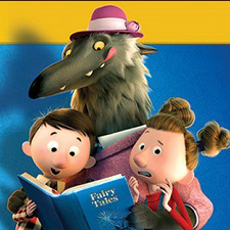Directors Chris Buck and Ash Brannon recently took time to talk with Animated News & Views’ Josh Armstrong about their latest feature, Surf’s Up. From Sony Pictures Animation, the animated documentary looks at the Penguin World Surfing Championship, where the young up-and-comer Cody Maverick hopes to achieve success. With AN&V, both Buck and Brannon reveal interesting stories regarding their direction for Surf’s Up, while also lending extra insight into some of their past experiences and future plans.
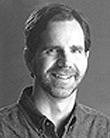 Born in Wichita, Kansas, Chris Buck studied for two years at the prestigious California Institute of the Arts, commonly referred to as CalArts. One of the first major projects he worked on was Disney’s The Fox and the Hound (1981), which he followed-up by helping with the short Fun with Mr. Future (1982). As his career continued to flourish, Buck likewise found animation work in commercials for such Los Angeles-based companies as Film Fair, Kurtz & Friends and Duck Soup.
Born in Wichita, Kansas, Chris Buck studied for two years at the prestigious California Institute of the Arts, commonly referred to as CalArts. One of the first major projects he worked on was Disney’s The Fox and the Hound (1981), which he followed-up by helping with the short Fun with Mr. Future (1982). As his career continued to flourish, Buck likewise found animation work in commercials for such Los Angeles-based companies as Film Fair, Kurtz & Friends and Duck Soup.
For Steven Spielberg’s Amazing Stories, Buck served as a key animator on the Brad Bird-directed episode titled Family Dog (1987). Afterward, he performed some experimental work on Who Framed Roger Rabbit (1988), before assisting in the design and animation of characters for the Disney films The Little Mermaid (1989) and The Rescuers Down Under (1990). Buck then moved to Hyperion Pictures, directing animation for the feature Bébé’s Kids (1992).
Throughout 1988-93, Buck returned to CalArts, teaching character animation classes. He also returned to Disney, where he became a supervising animator on Pocahontas (1995). His work on the movie’s character Grandmother Willow would earn him an Annie Award nomination for Best Individual Achievement for Animation. That highlight in Buck’s career was succeeded by a co-directorial position on the animated blockbuster Tarzan (1999) – a project that provided him and his co-director, Kevin Lima, an Annie Award nomination for Outstanding Individual Achievement for Directing in an Animated Feature Production. Likewise, Buck acted as a supervising animator for Disney’s Home on the Range (2004).
Now at Sony Pictures Animation, Buck has recently finished his latest directorial venture, Surf’s Up. Excited about the project, he shares some of its behind-the-scenes info, recalling memories from the film’s production. However, before talk of Surf’s Up could begin, there was one minor matter the Animated News & Views team wanted to be addressed…
Animated Views: Did you know your Internet Movie Database page credits you as actress for the Tim Burton short Doctor of Doom?
Chris Buck: It does?! Well, I am an actress in that… You’re kidding! Is that what it says?! [laughs] I wonder who put that in there.
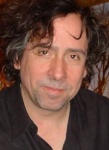 Yeah, it was a small film that we did with Tim. He asked me to play a Mexican waitress. So, I did. Her name was Pepe Quesadilla. So, there ya’ go, my biggest claim to fame!
Yeah, it was a small film that we did with Tim. He asked me to play a Mexican waitress. So, I did. Her name was Pepe Quesadilla. So, there ya’ go, my biggest claim to fame!
Tim kept telling me – because I said, ‘I want to look at myself!’ – he was doing my makeup, and he said, ‘No, no, no, I don’t want you to see yourself! No, no, no, you’ll be too self-conscious! Not ’til we’re finished filming can you look at yourself!’ I was horrified when it was over.
But I was only in a few scenes. It wasn’t a speaking role. We were dubbed. They dubbed us. It was supposed to be like a bad Mexican horror film. So, there you go! That’s pretty funny. I can’t believe it’s on IMDB.
AV: Speaking of Tim Burton, how was your experience working with him?
CB: Well, Tim is an old friend. I went to CalArts with Tim. We kind of grew up in the animation industry together. I’m a big fan of Tim. He’s always had that quirky sensibility, even since our first year at school.
But he’s an amazing guy. Even though in his sensibility, he can go to the macabre, his stuff is always appealing and actually very sweet, when you get down to it. He’s a very unique guy. I like him a lot.
AV: How was your transition from traditional to computer animation?
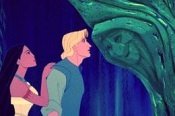 CB: It’s kind of interesting. It’s sort of a slow transition, even though it seems like I just suddenly leaped into it with Surf’s Up. On Pocahontas, I was animating the Grandmother Willow character. Her face was done traditionally, but the rest of the tree was done CGI, as was done the cowl around her face. So, that was sort of my first foray into it, and I was dealing with it as an animator, working with the CG there.
CB: It’s kind of interesting. It’s sort of a slow transition, even though it seems like I just suddenly leaped into it with Surf’s Up. On Pocahontas, I was animating the Grandmother Willow character. Her face was done traditionally, but the rest of the tree was done CGI, as was done the cowl around her face. So, that was sort of my first foray into it, and I was dealing with it as an animator, working with the CG there.
With Tarzan, we had the Deep Canvas backgrounds. Those were done on the computer, but we made them look like paintings, obviously to make it still feel like it was part of a 2D movie. But it allowed us to move around the jungle, like we did with all the flying scenes with Tarzan, the jungle surfing and all of that. That was my next step into it.
Then I did train a little bit on Maya before I left Disney. As an animator, I trained after Home on the Range and then to do Surf’s Up. So, it was kind of a slow move into it. It wasn’t like I leaped into Surf’s Up cold. I had a ramp up into it.
AV: How did you become a director for Surf’s Up?
CB: I was looking around to direct again. The project at Sony, Surf’s Up, was looking for two directors. Chris Jenkins pitched us the idea – Ash and myself, although it was separately.
I fell in love with the idea. I thought doing a documentary – or ‘mockumentary,’ whatever, but it really is kind of an animated documentary – I thought was really unique and fun. I was a big fan of a lot of the reality shows on TV.
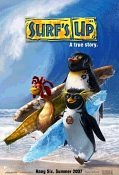 It just really spoke to me. Doing an animated movie like that – getting into the heads of an animated character, being able to do these talking head interviews along with all the action that we did – that sort of excited me the most. I also thought the penguins were as cute as can be. Then, surfing – I always wanted to surf. I’m trying to learn right now.
It just really spoke to me. Doing an animated movie like that – getting into the heads of an animated character, being able to do these talking head interviews along with all the action that we did – that sort of excited me the most. I also thought the penguins were as cute as can be. Then, surfing – I always wanted to surf. I’m trying to learn right now.
But it just was a lot of interesting things that came together that I thought, ‘Well, this could be something really fun!’ So that’s what got me in.
AV: What was the very beginning of development for Surf’s Up?
CB: Actually, Chris Jenkins, the producer, was the one who came up with it before Ash and I even got on it. It was in another – I think it was penguins in like a Romeo & Juliet story. They were wearing clothes, driving cars and all kinds of stuff.
Chris kind of said that didn’t really interest him. He made it more about surfing penguins and gave it a documentary twist. That’s where I think the genesis of that came from.
AV: Why was it decided to make Surf’s Up a documentary?
CB: It was just something that, when Chris decided there were going to be surfing penguins, to sort of do. Well, there have been a lot of surfing documentaries. Then, of course, reality TV is so popular right now. As a form of entertainment, it would be interesting to try that in animation. I think that’s where it came from, just wanting to actually try something different.
AV: How do you feel about Surf’s Up coming after such popular penguin films as Happy Feet and March of the Penguins?
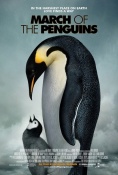 CB: Right. When we started Surf’s Up, we had no idea about the other movies. I know people find that hard to believe. But even though the animation industry is a small thing, we don’t always know what everyone is doing.
CB: Right. When we started Surf’s Up, we had no idea about the other movies. I know people find that hard to believe. But even though the animation industry is a small thing, we don’t always know what everyone is doing.
Of course, March of the Penguins is live-action and a documentary. Happy Feet – you know, I don’t even know the genesis of that. But it may have started as live-action – sort of a Babe-like thing that George Miller was doing. Of course, George Miller runs in different circles in the animation world. So, we didn’t really know about Happy Feet until probably we were a couple of years into our production.
We had already built models, and our story was already set, at least the basics of it. It wasn’t like we could just say, ‘Oh, we’ve got to change the animals, because someone else is doing something with penguins!’ It was a matter of, ‘Well, we’ll just run our course, and hopefully there’ll all very different movies.’ A good thing is that people like penguins!
AV: Regarding those penguin movies, especially Happy Feet, was there anything you felt you needed to change about Surf’s Up, because maybe a joke or a scene was just too similar?
CB: No, nothing was similar. But we have a nod to Happy Feet at the very beginning, in our very first interview with our lead, Cody, who’s played by Shia [LaBeouf]. There’s a nod to those ‘in the know.’ I think most people will catch it.
 AV: Could you elaborate on any other inside jokes or references in the film?
AV: Could you elaborate on any other inside jokes or references in the film?
CB: Hmmm… Inside jokes… that’s kind of tough. You know, we just sort of stayed in our own surfing penguin world. I’m trying to think if there are any nods to other movies. I don’t know. It escapes me. I don’t really think there are any!
Have you talked to Ash yet? He’s got a better memory than I do. I’m older, but he can still remember stuff!
AV: Could you elaborate on any plot ideas, characters or jokes that were deleted or abandoned from Surf’s Up?
CB: We had a couple of sidekicks for our Tank character. Tank is the villain of the movie. We had a couple of sidekicks. But they didn’t work out. We didn’t really need them. So, they got let go.
Jeff Bridges plays a character called The Geek and Big Z. [The character] had a history, and we had a scene where we got to know people from his past: his old girlfriend and other people that knew him in his past. It just took up too much of the movie. It became more of Big Z’s story than it did Cody’s story. It also gave the film a more somber tone, because his history – it was the downward spiral of this character. So, we put it up on reels and tried many variations of it. But it just never made the cut. We always seemed to lose those bits, just because it brought the film down too much.
 Also, we have three sports announcers. We have Sal Masekela, who you don’t really see in the movie, but you hear his voice. He’s from ESPN and the E! network; he’s on the X Games. Anyway, he plays our sports announcer, along with two of the top surfers in the world: Kelly Slater and Rob Machado. Those characters were originally sea lions. We turned them into penguins, just because they kind of looked better as penguins, and the sea lions were going to be too expensive to do. Well, I think we had one as a walrus, and one was a sea lion. To do them, with all the blubber and everything, was going to be really expensive. So, we opted to make them penguins. That was another batch of characters that kind of got lost along the way.
Also, we have three sports announcers. We have Sal Masekela, who you don’t really see in the movie, but you hear his voice. He’s from ESPN and the E! network; he’s on the X Games. Anyway, he plays our sports announcer, along with two of the top surfers in the world: Kelly Slater and Rob Machado. Those characters were originally sea lions. We turned them into penguins, just because they kind of looked better as penguins, and the sea lions were going to be too expensive to do. Well, I think we had one as a walrus, and one was a sea lion. To do them, with all the blubber and everything, was going to be really expensive. So, we opted to make them penguins. That was another batch of characters that kind of got lost along the way.
Story ideas – we took out a couple of luaus that were in the movie; they were fun stuff but just too long for the movie. They just didn’t work. We had a much longer act three – lots of surfing, with all our characters rising up through the ranks in the final competition. It just got too much – way too much. Of course, we found out in storyboards, luckily before any of this was animated.
Those are kind of the natural things that happen throughout these movies. You know, you usually put them up long and then try to edit them down to bare essence, just to get the tightest movie you can.
AV: Will any of those scenes be on the DVD?
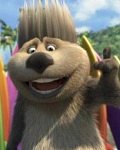 CB: Yes, you’ll see quite a bit of that on the DVD. And there’s more, too – there’s more than that. Yeah, there are some fun things.
CB: Yes, you’ll see quite a bit of that on the DVD. And there’s more, too – there’s more than that. Yeah, there are some fun things.
Reggie Belafonte, the James Woods character who is a surf promoter – we had a lot more of Reggie. It turned out that we didn’t need as much of a villain, because Cody Maverick, the lead, is kind of his own villain. In a way, it was a very internal struggle that he had, whether to go for the trophy or just enjoy life.
So, we didn’t need Reggie as much as we had him. We had more scenes of him in there. But it slowed the story down, even though James Woods did a killer performance, as he always does. It was so much fun working with him. We’re hoping if there is a sequel, there is a way to bring Reggie back and do a little more of him.
AV: Can you tell us anything else about the DVD?
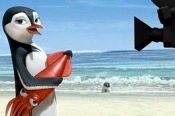 CB: There will be behind-the-scenes extras. We’ve got this amazing new camera that allows you to walk around the whole set, as this scene is already animated. You can walk around the whole set like it was a real documentary being filmed. It’s all done in real-time, so you get that real motion happening of, say, the cameraman wasn’t aware of the action happening off-screen. Suddenly, he whips over to catch what just happened or may have just caught the tail-end of it, just to give us that real documentary feel of something happening right in the moment. So, the camera guys were able to do that.
CB: There will be behind-the-scenes extras. We’ve got this amazing new camera that allows you to walk around the whole set, as this scene is already animated. You can walk around the whole set like it was a real documentary being filmed. It’s all done in real-time, so you get that real motion happening of, say, the cameraman wasn’t aware of the action happening off-screen. Suddenly, he whips over to catch what just happened or may have just caught the tail-end of it, just to give us that real documentary feel of something happening right in the moment. So, the camera guys were able to do that.
That’ll be on the DVD, showing how it’s done. They did it real-time. Once the scene was animated, it’s in the computer, and they could do the camera work, do one every couple of minutes. And just try it over again. If it didn’t work, they’d ‘Take one,’ and try it again. You know, ‘Take two. Take three. Take four.’ So, that was really amazing. Kind of the new camera work we’ve got. There will be a behind-the-scenes look at that, how it’s done.
Also, a behind-the-scenes extra on how we did a lot of the voice recording. We brought in several actors at once to get that feeling like the scene was really happening in the moment. You get the actors overlapping each other’s lines a bit. You get to dirty it up a bit, so it’s not too perfect or too sterile.
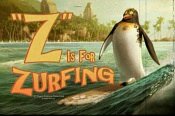 A documentary wouldn’t always get that perfect shot. That’s what we tried to do, along with everything else. Even the look of the movie – we have different looks, archival-type footage with scratches on it. We did video-type footage for the sports broadcast, with lines running across it. Then, of course, even the most pristine stuff we did still had a little bit of ‘film grain’ on it that we added, just to give it a little less perfect look, so that it felt like it was shot on film, as opposed to just done on a computer. So, lots of little things like that – some of those will be explained on the DVD extras.
A documentary wouldn’t always get that perfect shot. That’s what we tried to do, along with everything else. Even the look of the movie – we have different looks, archival-type footage with scratches on it. We did video-type footage for the sports broadcast, with lines running across it. Then, of course, even the most pristine stuff we did still had a little bit of ‘film grain’ on it that we added, just to give it a little less perfect look, so that it felt like it was shot on film, as opposed to just done on a computer. So, lots of little things like that – some of those will be explained on the DVD extras.
AV: Regarding the idea of penguins surfing, why was surfing chosen as the sport?
CB: That’s a question for Chris [Jenkins]! I don’t know how the surfing came about. All I know is that it’s a great metaphor for life. When a person surfer – a good surfer – becomes one with the wave, and they’re not fighting the wave any more, things just seem to happen. They’re one with the ocean, one with the Earth, one with life.
The lesson we try to get in the movie is kind of the same thing. It’s like, stop fighting life so much. Just kind enjoy of ride and relax, and it will all be okay. I think that’s probably why – I mean, that’s certainly what we adapted throughout the movie for our characters, and that may have been why it was chosen.
AV: Speaking of surfing, it’s been reported that Chris Jenkins wanted certain members of the Surf’s Up crew to learn how to surf. Were you one of them?
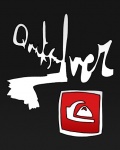 CB: We originally went out with Quicksilver, a promotional partner of ours. They actually got a lot of our surfers connected to our movie and got us to be able to interview all these guys. They took us out – Ash, Chris and myself – to Seal Beach for our first little lesson. And this is in March – we started in ’04 – I think ’05. So, it was kind of chilly out there. We had our wetsuits and everything. We didn’t do that well! But that was our first foray into it.
CB: We originally went out with Quicksilver, a promotional partner of ours. They actually got a lot of our surfers connected to our movie and got us to be able to interview all these guys. They took us out – Ash, Chris and myself – to Seal Beach for our first little lesson. And this is in March – we started in ’04 – I think ’05. So, it was kind of chilly out there. We had our wetsuits and everything. We didn’t do that well! But that was our first foray into it.
Then we had a surf day. We took quite a few people out to Zuma Beach, including members of the crew and staff. Then we got to learn a little bit more and everyone got a chance to get on the boards – and, of course, wipeout! Then we did it about a year later. We took even more people out. That was about a year ago. More of the artists got out there and really felt what it was like to get on the board, to try to paddle out. Of course, some already knew, and some were quite good. But most of us, it was our first time in there, just to feel the power of the ocean and feel what it’s like to wipeout and bring that to the movie. I think a lot of it the guys would talk about for months after.
Just feeling and experiencing it is a huge part of all these movies. On Tarzan, we went on a safari to Africa. We got to study all of the animals there and got to go visit the mountain gorillas. That was a huge moment for us. We brought so much back of that and put it in the movie. So, any of the real stuff you can do and bring back, it just makes the movie a little more believable, even though it’s animation. There’s still believability to it that people connect with. I think that’s real important.
AV: Regarding the cast for Surf’s Up, how did you decide which actors would suit certain characters?
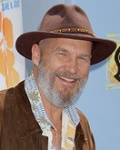 CB: Well, Jeff Bridges, for the Z character, was always our first choice. He just had that laid-back attitude. He was just perfect for this surfer that’s dropped out for years. He was our first choice. We kept going and going for him. It was harder to get to him than it was to sell him. I mean, once he saw the artwork and kind of got the whole vibe of the story, he was totally hooked. He was good. It was just getting through all the layers to get to him.
CB: Well, Jeff Bridges, for the Z character, was always our first choice. He just had that laid-back attitude. He was just perfect for this surfer that’s dropped out for years. He was our first choice. We kept going and going for him. It was harder to get to him than it was to sell him. I mean, once he saw the artwork and kind of got the whole vibe of the story, he was totally hooked. He was good. It was just getting through all the layers to get to him.
All the others were pretty much our first choices, too. Shia LaBeouf – he was a great actor already. Of course, now he’s doing gangbusters with Disturbia and Transformers and Indiana Jones 4. He could play the comedy and play the drama.
You probably know how we choose the voices. We just listen to tracks from other movies and try to figure out if they fit with our characters. We’ll play those tracks up against sketches of our characters to just see if they fit. So there’s that.
We got Zooey Deschanel, a great, interesting voice and quirky actress. She gave it that fun bit to our female lead, Lani. James Woods – brilliant, of course. Mario Cantone – Ash had seen one of Mario’s one-man comedy shows in New York and thought he would be great for the talent scout Mikey. Sure enough, he was and is.
Then, Jon Heder for Chicken Joe – we had just seen Napoleon Dynamite when we had started to cast, and we just went, ‘This guy is fantastic!’ We almost felt like he wasn’t even acting. He just had that kind of great edge to this kind of quirky, nerdy character. But he was so funny. We fell in love with that. Chicken Joe has become a favorite of the audiences, too.
Then, Diedrich Bader – we found a really deep voice that again could do great improv. That’s another thing we asked all our actors if they would love to do, because that’s what we were going to try to do, a lot of improv on the movie. Everybody who signed up obviously wanted to do it and had a good time. But Diedrich, the same way, we wanted something other than just the normal kind of villain. He gave it that quirky edge.
 A lot of the cast members were our first choices. We just went after who we really liked. Now, the kids in the movie are played – the little Arnold character, my son [Reed] plays. That was just kind of a fluke. I don’t know if you know what scratch dialogue is, but it’s just when people around the studio kind of record lines to see if a scene is going to work at all before we go to the real actors. We needed a kid actor to do this one scratch part. So, I just brought the DAT recorder home and tried it out with my kid. It kind of stuck; it also added that improv feeling. He’s not an actor. But we got a natural performance out of him. Then, Chris’ girlfriend’s daughter plays one of the little kids, too.
A lot of the cast members were our first choices. We just went after who we really liked. Now, the kids in the movie are played – the little Arnold character, my son [Reed] plays. That was just kind of a fluke. I don’t know if you know what scratch dialogue is, but it’s just when people around the studio kind of record lines to see if a scene is going to work at all before we go to the real actors. We needed a kid actor to do this one scratch part. So, I just brought the DAT recorder home and tried it out with my kid. It kind of stuck; it also added that improv feeling. He’s not an actor. But we got a natural performance out of him. Then, Chris’ girlfriend’s daughter plays one of the little kids, too.
That was fun. The little kids – a lot of their little scenes together are some of the most charming moments in the movie. They’re all real. They’re all little real moments.
Then Kelly Slater and Rob Machado – surfers in the movie, the real deal – they played roving reporters, and then Sal Masekela – they came in via Quicksilver. We met Sal at lunch one time and just said, ‘How can we use this guy? This guy is fantastic!’ Sure enough, the announcer part came up and then the roving reporters also. Like I said, they were sea lions, and we changed them to penguins. Kelly and Rob were just perfect for those guys.
AV: What was the largest challenge for you in co-directing Surf’s Up?
CB: The technical end of it, I wasn’t too worried about, because I know the guys at Imageworks can do almost anything. They’re geniuses over there. We did say to them, ‘If we can’t do the water well, then we can’t do this movie.’ We were going to have so many waves and so much water. It just has to look great. Of course, they came up to the challenge. They did way better than I could have even dreamed. But that really wasn’t a challenge for me, per se.
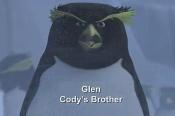 You know what it was? It was probably trying to convince people along the way that this could be something really fun and special, because it’s different. When you do something different like this documentary, a lot of people may just not understand it, or they just don’t think that people will enjoy it or whatever.
You know what it was? It was probably trying to convince people along the way that this could be something really fun and special, because it’s different. When you do something different like this documentary, a lot of people may just not understand it, or they just don’t think that people will enjoy it or whatever.
I know convincing people that kids would get it was a hard one, too. They kept saying, ‘Well, kids aren’t going to get a documentary. Kids don’t watch documentaries.’ But kids watch reality TV. They watch a lot of that. My kids do. This is the same as that.
You can call it whatever you want to call it: ‘documentary’ or ‘reality TV.’ It’s a slice of life, what’s happening right then in the moment. Kids have just loved it, and they don’t question it at all. They don’t even call it a ‘documentary.’ It’s just entertaining to them.
So, I think that was our hardest thing along the way. Until scenes were animated or sequences were really done did others outside of Ash, Chis and myself really understand it – did they finally go, ‘Oh, okay, I kind of get what you’re doing!’ – or until they showed it to an audience were their fears put to rest. So, that was the biggest challenge. That was ongoing. Not until you could show a finished product could you prove it.
 AV: What can you tell us about some of your upcoming projects?
AV: What can you tell us about some of your upcoming projects?
CB: Well, I can’t really say what’s next. I think I’ll probably be staying at Sony and doing another movie there, probably working with Chris Jenkins again. I think that’s all I can say right now.
AV: Could you say whether you’re planning to continue with computer animation or are you considering a return to traditional animation?
CB: It’s probably going to be computer animation, as far as I know. That’s the plan right now. I love traditional, though! I come from traditional. I love it with all my heart, and I’m excited to see it making a comeback.
My good buddy Kevin Lima is doing Enchanted. They’ve got some good hand-drawn stuff coming back there. Then, there’s John Musker and Ron Clements doing The Princess and the Frog. As long as it’s a good story, that’s what it’s all about.
 AV: What advice do you have for anyone wanting to work in the animation industry?
AV: What advice do you have for anyone wanting to work in the animation industry?
CB: I say this to my kids: Follow your passion. I’ve loved drawing all my life. As a little kid, I was always drawing and always creating stories and characters and all that. I followed my passion all the way to art school, even though I didn’t know if I’d be any good at it. But at least I said, ‘Well, I’ll give it a shot.’ I went to CalArts, got in and gave it a shot. Luckily, I got into Disney and kept pursuing it.
I would say, follow your passion. Stick with it. It’s going to get you places. No matter what you do, if you can make a living doing what you love, hallelujah! That’s the best thing in the world.
Studying in CalArts’ Character Animation program, Ash Brannon also honed his skills as an animator on Disney’s The Little Mermaid (1989). From 1990-92, he taught at CalArts, before animating on such projects as Nike’s Hare Jordan Super Bowl ad (1992) and the television series That’s Warner Bros.! (1995).
At Pixar Animation Studios, he worked as a story artist and directing animator on Toy Story (1995), as well as a story artist on A Bug’s Life (1998). Brannon was then assigned Toy Story 2 (1999), back when the sequel was planned as a direct-to-video feature. He helped helm that picture, in addition to writing, animating and designing characters for it. Brannon’s work for Toy Story 2 brought him two Annie Award wins, for direction and writing.
Afterward, Brannon pursued independent interests, selling a film pitch titled Space Monkey (2002) to DreamWorks Animation. That led to his assisting with the company’s Over the Hedge.
At this time, Brannon is pleased to promote his latest directorial effort, the critically-acclaimed Surf’s Up from Sony Pictures Animation. With much enthusiasm, he talks about the making of the feature. In addition, Brannon briefly recalls his time at Pixar.
 Animated Views: How would you describe your experience co-directing Toy Story 2?
Animated Views: How would you describe your experience co-directing Toy Story 2?
Ash Brannon: It was an incredible experience, working with the team up there. I learned almost everything I know about the process by working with John Lasseter and Joe Ranft, at the time, and Andrew Stanton. It’s a great team – everyone knows that. It was just a great trip.
AV: You were involved with the movie back when it was to be a direct-to-video feature. Could you elaborate on that period? What were some of the big differences in the film?
AB: Let’s see… It was going to be just over an hour long, I think. So, we originally structured the movie to be that length. Then, when it went theatrical, it was quite a challenge to open up the film to a 15- to 20-minute longer running time, without padding the story.
But you know, John and Pete Docter and some of the other guys up there came up with a great premise. Then, Pete, Jeff Pidgeon and I kind of ran with it in discovering what could have made Woody so valuable. Then, the TV show idea came up, and Buzz meeting Buzz came up. The characters were so well-developed from the first film that there were so many things you do with them. You didn’t run out of ideas, working with those characters.
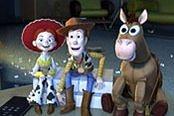 Yeah, it was a trip, and it was a great thing that all the actors came back on. At first, we thought we’d get only sound-alikes. But the whole cast came back and more, with Joan Cusack, Kelsey Grammer and Wayne Knight.
Yeah, it was a trip, and it was a great thing that all the actors came back on. At first, we thought we’d get only sound-alikes. But the whole cast came back and more, with Joan Cusack, Kelsey Grammer and Wayne Knight.
AV: You mentioned sound-alikes for the characters. Do you remember whom some of the replacements might have been?
AB: Not precisely. I just know they had sound-alikes who had done work for the original Toy Story – you know, maybe for a commercial or one of the toys, for the voice box of the toy, that kind of thing. They were considering them. But I can’t remember all the names of the people who were considered.
AV: Not a lot is known regarding your career between Toy Story 2 and Surf’s Up. Could you elaborate on that period?
AB: Yeah, I took some time off. These films you work on – they just consume you. I hadn’t seen my wife in a long time. We wanted to travel, so we did a lot of traveling – did our own stuff just on our own time. I was fortunate that I could take time off.
Then I was at DreamWorks for a while, working on Over the Hedge with Tim Johnson. When I left there, it was perfect, because Surf’s Up was at just the right point for the directors to come on. I got a meeting over here, looked at it and fell in love with it.
In fact, I’ve had to take more time off now. My wife and I just had a baby. I’m not the type who likes to just do back-to-back projects. I like to take some time off in-between and kind of enjoy life.
AV: In making the transition to Sony Pictures Animation, what are some of the differences you’ve noticed in the studios you’ve worked for?
AB: They all have their different identity, and they all change their identity over time. Pixar was a really different place when I started there than it is now. It was a much smaller crew.
In the same way, Sony is still kind of a small studio. They’re just planting their feet. There’s a real enthusiasm because of that. Everybody is in the trenches together. There’s excitement, and there’s lots of willingness to take risks with these movies. They want to stand out from the crowd.
There are a lot of really great animation studios in town now. Every one needs to find a way to innovate, be different and find their identity that way.
AV: How did you become involved with Surf’s Up?
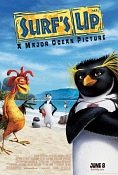 AB: As soon as I left DreamWorks, the word got out at Sony that I was free. They called me over to take a look at it. I met the producer, Chris Jenkins. It was really when he said ‘documentary’ that the light flashed in my head. I said, ‘I’ve got to do this,’ because the idea of doing something fake and making the audience believe that it’s real appeals to me. I dig that kind of thing.
AB: As soon as I left DreamWorks, the word got out at Sony that I was free. They called me over to take a look at it. I met the producer, Chris Jenkins. It was really when he said ‘documentary’ that the light flashed in my head. I said, ‘I’ve got to do this,’ because the idea of doing something fake and making the audience believe that it’s real appeals to me. I dig that kind of thing.
You know, being able to talk to a character, put a microphone in his face and talk to him, or creating fake archival footage of penguins surfing back in the ’20s – I love it. Chris Jenkins, Chris Buck and I were really like-minded, in that way. It was a great team to come together and make a movie like this.
AV: What was the very beginning of development for the film?
AB: That started with the producer, Chris Jenkins. He took an idea that was being tossed around at Sony. It wasn’t a documentary at the time. This was like five years ago. It was surfing penguins, but they wore clothes and drove cars. It was really different.
He kind of stripped down the idea to its basics and said, ‘What if we told it documentary-style?’ It’s a sports movie, and it’s a surfing movie. There are a lot of surf documentaries out there. There’s something really cool about the surf culture and the idea that riding the waves is a metaphor for life.
He wrote a treatment and was working with the development team here. So, when Chris Buck and I got on here, they had this treatment. We just started expanding it. We’d sit in the room every day for the first year, just thumbnailing ideas, expanding the scope of the movie and going through a lot of ‘What if’ conversations.
AV: Why was surfing chosen as the sport for the movie?
 AB: I’m not sure why it was surfing. I should have asked that, you know? You’d think I’d know that, but I don’t.
AB: I’m not sure why it was surfing. I should have asked that, you know? You’d think I’d know that, but I don’t.
Penguins in real-life actually do surf. There’s a nature photographer who’s taken pictures of them on their hind legs riding waves. It’s amazing.
They’re really anthropomorphic. They have a real human quality to them already. What else was it about them… They look like they’re wearing wetsuits. They’re just really good paddlers too. With their fins, they can swim like 4x faster than people underwater.
They had that athletic ability. They had the wetsuits, the insulation. They can stand up on their hind feet. Not a lot of animals can do that. Them and kangaroos are kind of the two animals who are up for standing on their hind feet and riding a board.
AV: How do you feel about Surf’s Up coming after such popular penguin films as Happy Feet and March of the Penguins?
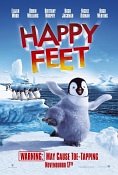 AB: We heard about the movies when we were well into production and said, ‘Oh, okay. That’s cool.’ We knew our movie was different. So, it didn’t really bother us that much. We just put our heads back down and kept working on our movie.
AB: We heard about the movies when we were well into production and said, ‘Oh, okay. That’s cool.’ We knew our movie was different. So, it didn’t really bother us that much. We just put our heads back down and kept working on our movie.
But I think it’s a positive thing. Penguins, I think, are perennial favorites. We’re doing really different things with them, in this movie.
A lot of people who say it’s ‘another penguin movie’ – and we hear that a lot, and it’s understandable – but the people who say it haven’t seen our movie. Once they have, they usually don’t call it ‘just another penguin movie.’
AV: Regarding Happy Feet, when you saw the film, was there anything that you felt you had to change in Surf’s Up, because maybe a joke or a scene was just too similar?
AB: I didn’t see Happy Feet, almost for that reason. I just didn’t want to be influenced by it in any way. We do make one nod to it in the beginning of the movie, where we ask Cody if he can sing or dance. That’s as far as we went. We felt like we had to give a nod to it.
AV: What are some of other inside jokes or references to be found in Surfs Up?
AB: Oh, well, there’s one – I don’t think anybody’s talked about this one, so you’ve got a scoop here. It’s not that big a deal, but… You’ll have to do a little detective work on this one, how’s that?
AV: [laughs] Okay!
 AB: There are some native-type penguins who chase after our character Chicken Joe. At one point, they speak their own language. One of them utters a phrase that translates to ‘Tastes like chicken.’ But the phrase he says is, ‘Hokana Matusu.’ It’s from a really big movie from the ’80s. Shia LaBeouf has a connection to it. How’s that?
AB: There are some native-type penguins who chase after our character Chicken Joe. At one point, they speak their own language. One of them utters a phrase that translates to ‘Tastes like chicken.’ But the phrase he says is, ‘Hokana Matusu.’ It’s from a really big movie from the ’80s. Shia LaBeouf has a connection to it. How’s that?
AV: We have some film buffs at Animated News & Views. Maybe one of them will know the answer.
[Note: The phrase ‘Hokana Matusu’ was featured in Raiders of the Lost Ark. Thanks, Ben!]
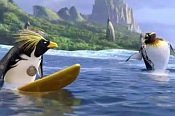 AB: We also have flying saucers in the movie. I don’t know if you’ve heard about that. I’m a UFO fanatic. The tech crew found out about that. So, as a joke… Every day, we’d go to digital dailies. We’d go to the screening room and look at the latest shots in lighting, as we worked on the waves and all that. They started hiding flying saucers in some of the shots. I think they got ten or so UFO’s in the movie. That’s something you can look for. It’s a little Easter Egg.
AB: We also have flying saucers in the movie. I don’t know if you’ve heard about that. I’m a UFO fanatic. The tech crew found out about that. So, as a joke… Every day, we’d go to digital dailies. We’d go to the screening room and look at the latest shots in lighting, as we worked on the waves and all that. They started hiding flying saucers in some of the shots. I think they got ten or so UFO’s in the movie. That’s something you can look for. It’s a little Easter Egg.
References to other movies and that kind of thing – I’m glad you brought that up. To be really serious now – as serious as I can be about a cartoon – we just didn’t want to make a movie that does a lot of pop culture references, because we didn’t want it to date itself where people would look at it in 20 years and not get the references. We wanted it to have a timeless quality. So, it was really important to us that we didn’t do that kind of thing.
You know, it’s a primitive penguin world, where everything is built out of bamboo and leaves. In a way, that was a real benefit for us, because it was kind of hard to do product placement. You can’t have a can of soda in there, or whatever. But I’ll quit my diatribe.
AV: Could you elaborate on any plot ideas, characters or jokes that were deleted or abandoned from Surf’s Up?
AB: Yeah, quite a few… Let’s see… We had a, um, what do they call it, a ‘spoiler’? So, here’s kind of a spoiler: The Jeff Bridges character [The Geek/Big Z] is someone who is a legend back in the day. Then he apparently died. But in our movie, it’s revealed that he didn’t die. He’s Cody’s hero. The movie is all about Cody meeting his hero and dealing with that.
So, we had a subplot that went back and used archival footage to explain how Z’s career and life got off track. We had like three sequences that showed the beginning, middle and end of Z’s career – the rise and fall. It was entertaining and all that, but it ended up, first of all, kind of telegraphing what we wanted to be kind of a surprise at the end of act two. It also just took you away from Cody’s story. So, we put everything up on reels, and that was the first thing to go. That’s how it goes sometimes.
A lot of comedy – yeah, that always happens – gags have to go. But we tried to let the story happen first and then supplement it with humor, and let the humor actually come from the characters and not from, you know, a guy slipping on a banana peel.
AV: What can folks look forward to on the Surf’s Up DVD?
AB: Ah, yeah, it’s going to be chock-full of material. They have a lot of behind-the-scenes [extras]. A lot of our voice recording sessions, so we see how a lot of our actors were working together in the booth. A lot of technical information on how the waves were created. How we shot with a handheld camera style, which was a real innovation. A lot of stuff for the kids. It’s going to be a nice DVD.
AV: What was the largest challenge for you in co-directing Surf’s Up?
AB: I guess the biggest one was committing wholeheartedly to the documentary style, because creatively, it was a challenge, and kind of politically, it was a challenge. We had a studio that ultimately embraced doing a movie in a different way. They really embraced it. We really appreciate that.
But it wasn’t always easy for them to embrace the idea. It took some time. We always had to really stand by it and articulate why it had to be done this way. We really, really believe in telling the story this way, from beginning to end.
Artistically, it gave you limitations. We wanted to limit where the camera could go. It can’t be totally evasive. It can’t be omnipresent, like you can do in a narrative. There were artistic challenges like that. So, I think it was really just embracing the documentary and holding fast to that and protecting that for the duration of the production.
AV: Another challenge was Chris Jenkins’ wanting some Surf’s Up crew members to learn how to surf. Were you one of those who had to learn, or did you already know?
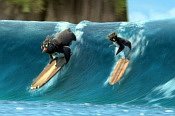 AB: No, I had to learn. The whole crew went out to a local beach and learned how to wipeout really well, myself included! But what we learned about surfing, ultimately, I got pretty good. We were in Hawaii a few weeks ago. I caught a few great waves. It was an incredible experience to feel what it’s really like, because up ’til then, I couldn’t ride more than a couple seconds!
AB: No, I had to learn. The whole crew went out to a local beach and learned how to wipeout really well, myself included! But what we learned about surfing, ultimately, I got pretty good. We were in Hawaii a few weeks ago. I caught a few great waves. It was an incredible experience to feel what it’s really like, because up ’til then, I couldn’t ride more than a couple seconds!
But we kind of learned, too, that it’s not just about riding waves. Surfing is a way of looking at life and being in the moment, not thinking too much about tomorrow and not worrying too much about yesterday. We wanted to embrace that, in the movie and in the way we made the movie. Even if you didn’t catch a wave, just being out there in the water, being with nature, was a great, incredible trip.
AV: Regarding the cast for Surf’s Up, how did you decide which actors would suit certain characters?
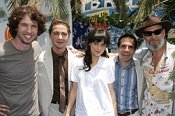 AB: We kind of had our wish list, at the beginning. We worked on creating the characters, to a certain point. You can’t take them the whole way, because animation is real collaborative. You have to leave room for people like the actors and the character designer and that kind of thing, too, to round out the character. But we had a pretty clear sense of who these guys were.
AB: We kind of had our wish list, at the beginning. We worked on creating the characters, to a certain point. You can’t take them the whole way, because animation is real collaborative. You have to leave room for people like the actors and the character designer and that kind of thing, too, to round out the character. But we had a pretty clear sense of who these guys were.
Then we started saying, ‘Who could play Big Z? Who could play Cody?’ We started making a wish list. I think we got our #1 choice on everyone. We knew Jeff Bridges had to be Z, for a long time. We finally got him into the studio. Got to pitch it to him, show him the artwork and a little test we did. He got hooked, and he brought so much to the character just by being able to live with him for a couple of years. You know, coming to a session, working with Shia, working on the material – we call it ‘workshopping.’ We have a script, but it’s not a bible at all. It’s not like we have to record exactly as written. It’s more about the intentions. It’s about making sure we get from A to B to tell the story and progress it.
The actors brought so much of themselves to the roles. But as I was saying, they’d come in; they’d record. They’d go away for a few weeks or months and then come back. We could show them the story reels where their voices cut in. They could look at it and say, ‘Okay, we’re starting to understand where it’s going.’ Then they could grow the character over the course of production.
 Again, we had a pretty good idea of who we wanted. Our casting director – her name is Mary Hidalgo – she was really helpful, especially finding Shia. At the time, he didn’t have Indiana Jones 4 or Transformers. We were lucky to get him at the time. He could play a teenager – he was a teenager, at the time. He really connected with the challenges a teenager goes through at that stage in life.
Again, we had a pretty good idea of who we wanted. Our casting director – her name is Mary Hidalgo – she was really helpful, especially finding Shia. At the time, he didn’t have Indiana Jones 4 or Transformers. We were lucky to get him at the time. He could play a teenager – he was a teenager, at the time. He really connected with the challenges a teenager goes through at that stage in life.
AV: What can you tell us about some of your upcoming projects?
AB: Well, [my wife and I] just had a baby. I’m not in a huge hurry to get working again. I just like to take time off, stay home, feed the baby and change his diapers for a while. Having him in my life now changed everything. I just miss him and my wife. It will be nice to be home for a while.
I’m thinking about new ideas and things like that, but nothing concrete. I’m not in a big hurry to do so.
AV: At this time, can you say whether or not you’re planning to stay at Sony?
AB: Oh, I do want to stay here. They have an incredible team of artists and technical geniuses. It’s really and truly incredible. You know, you work with people long enough, they become, in a way, like a family. I’d really miss that. So, yeah, I do want to stay here.
 AV: Are you hoping to work more with computer animation, or have you also considered traditional animation?
AV: Are you hoping to work more with computer animation, or have you also considered traditional animation?
AB: For me, it’s important to innovate every time. You do these things, and they take 3 to 4 years of your life. The last thing you want to do is the same old thing or repeat yourself.
I do like the CG medium. It’s so close to live-action. What I’d like to see is more innovated ways of telling stories and maybe even the way you style the film. We didn’t set out to make a realistic-looking movie. The water – breaking waves and all that – it kind of demanded a certain degree of realism. But I love seeing really stylized, really cartoony looks, and I’d love to do something different like that, for example.
AV: What advice do you have for anyone wanting to work in the animation industry?
AB: It’s the best. I really think we’re at a great moment and time for animation to keep innovating. It’s got to, to survive, because there are so many great studios in town.
The best thing you can do is learn story. You know, take drama classes, or learn to draw. That’s a really – even if you’re talking 3D – learning to draw and knowing how to communicate ideas visually, it’s such an important thing. I was drawing all the time on this movie. In meetings, I boarded about half the movie on my own, in editorial. Drawing – you’ve got to know how to do that. That’s not going to change, no matter how smart the computers get.
Then, really, just never give up. It’s a tough business. But you stick to your guns. Believe in what you’re working on, and believe in yourself. I know it’s cliché, but it’s true. There’s a truth to clichés. You really can do anything that you set out to do.
Sincerest gratitude to Chris Buck and Ash Brannon for participating in these conversations. Likewise, we certainly appreciate David Hail arranging the interviews for Animated News & Views.




